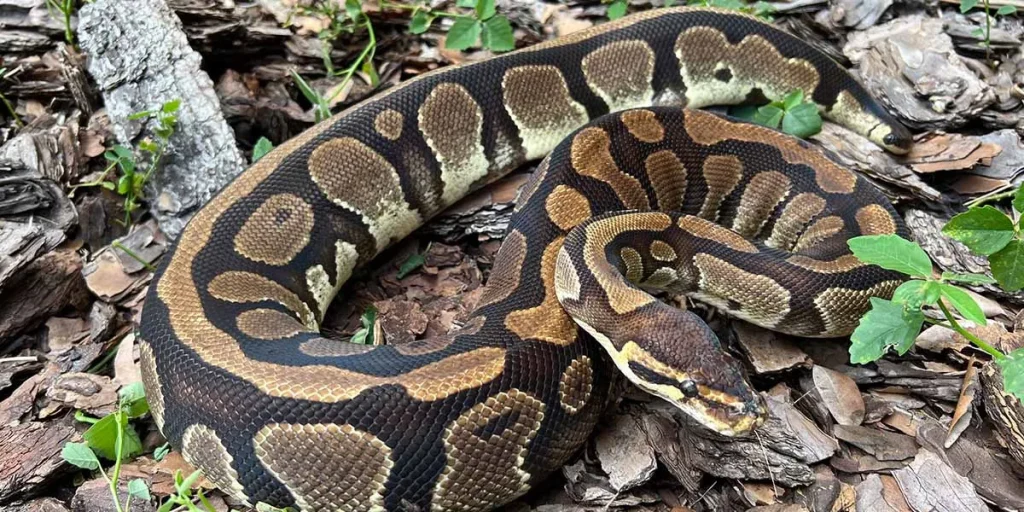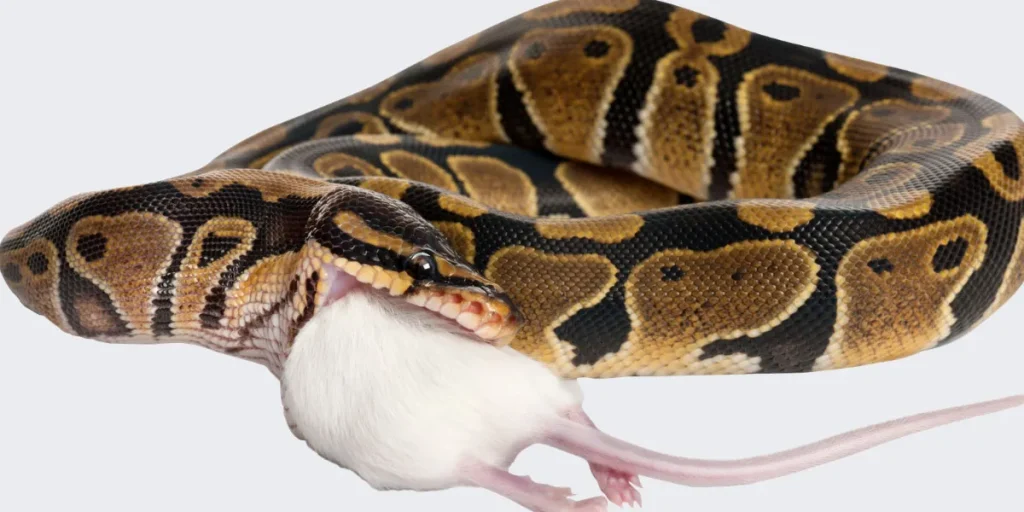Adult ball pythons typically weigh between 1200 to 1600 grams. Hatchlings usually start at around 50 to 100 grams.
Ball pythons, also known as royal pythons, are popular snakes in the pet industry due to their manageable size, easy-going temperament, and wide variety of morphs.
Originating from Western and Central Africa, these snakes can live for up to 30 years with proper care.
As they grow, their weight varies based on diet, gender, and individual genetics. Female ball pythons often outweigh males, as they are generally larger.
Pet owners and breeders should monitor their ball python’s weight to ensure they maintain a healthy girth proportional to their length, as both underweight and overweight can be health concerns.
A consistent weight tracking routine helps in detecting any potential health issues early on.
Getting To Know Ball Pythons
Ball pythons are fascinating creatures that captivate reptile enthusiasts around the world. Their manageable size and docile nature make them excellent pets.
To fully appreciate these snakes, delve into their native habitat and species varieties, as well as their physical features.
Understanding these aspects can help owners provide better care for their scaley friends.
Native Habitat
These pythons originate from West and Central Africa. They enjoy warm, tropical climates and are often found in grasslands and open forests.
Known for their shy nature, ball pythons prefer burrows or other hidden spots during the day.
- Grasslands and open forests are their favorite.
- Shy and secretive, they seek shelter in burrows.
Species Varieties
Ball pythons come in an array of patterns and colors, known as morphs. Breeders have developed over a thousand morphs! Some popular varieties include:
- Piebald: Distinctive patchy pattern.
- Albino: Bright yellow and white coloring.
- Spider: Thin, web-like markings.
Physical Characteristics
A full-grown ball python usually weighs between 1200 to 1700 grams. Males tend to be smaller than females. Hatchlings are born at weights of approximately 50 to 150 grams.
| Age | Weight Range |
|---|---|
| Hatchlings | 50-150 grams |
| Adult Males | 800-1,000 grams |
| Adult Females | 1,200-1,700 grams |
Their average length ranges from 3 to 5 feet, with a sturdy, muscular build, distinct head, and a sharply tapered tail.
Average Weight Range

The average weight range of ball pythons is a topic of interest for many reptile enthusiasts and potential pet owners.
These snakes have a varying range of weights depending on their age, diet, environment, and genetic factors.
Understanding these weight ranges can help ensure proper care and inform breeders and owners about the health and development of their ball pythons.
Hatchlings And Juveniles
Newly hatched ball pythons, known as hatchlings, typically weigh between 50 to 100 grams. As they grow during their juvenile years, these weights increase proportionally.
By the time they reach one year, juveniles may weigh from 400 to 800 grams, showcasing a rapid growth phase in their lifecycle.
Adult Ball Pythons
When ball pythons reach adulthood at around 2 to 3 years of age, their weight stabilizes. Adult female ball pythons generally weigh more than males.
Females typically range from 1200 to 1800 grams, while males average between 800 to 1400 grams. Some females, especially breeders, can exceed these averages, reaching upwards of 2000 grams or more.
Factors Influencing Growth
- Diet: Adequate and nutritious feeding schedules contribute to healthy weight.
- Genetics: Some pythons are predisposed to be larger or smaller.
- Habitat: Proper temperature and humidity support better growth.
- Health: Parasites or diseases can affect weight negatively.
By monitoring these factors, owners can manage their ball python’s growth effectively.
Dietary Habits And Their Impact

Understanding the dietary habits of ball pythons is crucial. It affects their health and weight.
A well-balanced diet ensures they maintain a healthy weight range. Here’s how dietary habits influence a ball python’s weight.
Feeding Frequency
Feeding frequency affects a ball python’s growth and weight. Young pythons eat more often than adults.
- Hatchlings: Once every five days
- Juveniles: Once every week
- Adults: Once every one to two weeks
Common Prey And Supplements
Ball pythons eat frozen-thawed rodents mainly. Live prey is riskier and can injure the snake. Supplements are not usually necessary with a proper diet.
| Prey Size | Snake Weight |
|---|---|
| Mice or small rats | Hatchlings to small juveniles |
| Medium to large rats | Adults |
Overfeeding Consequences
Overfeeding leads to obesity and health issues. These include fatty liver disease, stress, and a shortened lifespan.
- Signs of obesity: Excess fat rolls, difficulty moving
- Prevention: Follow recommended feeding schedules
Growth Milestones And Timeline
Understanding the growth milestones and timeline of ball pythons is essential for owners. These fascinating creatures follow a distinct growth pattern from hatchling to adulthood.
Monitoring their weight and size not only helps in ensuring they are healthy but also provides insights into their life stages.
First Year Growth Patterns
During the first year of life, ball pythons experience rapid growth. Upon hatching, these snakes weigh approximately 50 to 100 grams.
Feeding them a suitable diet, they can reach up to 750 grams within their first year. Regular weigh-ins help track their progress.
- Hatchling weight: 50-100 grams
- 6 months weight: 300-400 grams
- 1-year weight: 600-750 grams
Reaching Sexual Maturity
Ball pythons typically reach sexual maturity between 18 to 36 months. Throughout this period, males may weigh between 600 to 1000 grams, whereas females are heavier at 1200 to 1400 grams.
Sexual maturity is associated with sufficient weight and age rather than a fixed timeline.
| Age | Male Weight | Female Weight |
|---|---|---|
| 18 months | 600 grams | 1200 grams |
| 24-36 months | 1000 grams | 1400 grams |
Longevity And Weight Stability
With proper care, ball pythons can live for 20 to 30 years. After reaching maturity, their weight stabilizes.
An adult male usually weighs between 1000 to 1400 grams, while an adult female ranges from 1400 to 2000 grams. Steady weight is indicative of good health.
- Adult male weight: 1000-1400 grams
- Adult female weight: 1400-2000 grams
- Lifespan: 20-30 years
Monitoring Your Ball Python’s Weight
Keeping an eye on your ball python’s weight is crucial for ensuring its health and well-being. An abrupt weight change can be a telltale sign of health issues.
Regular monitoring helps you react quickly to potential problems and keep your serpent friend in top shape.
Let’s delve into the best practices for tracking your ball python’s weight.
Regular Weigh-ins
Conducting regular weigh-ins is an essential part of caring for your ball python. Here are some tips:
- Use a digital scale for accuracy.
- Weigh your python once a week for consistency.
- Record the weight to track changes over time.
Keeping consistent records helps identify trends and maintain optimal health.
Ideal Weight Ranges
Ball pythons have ideal weight ranges based on their length and age. See the table below:
| Age | Length | Ideal Weight |
|---|---|---|
| 6 months | 18–24 inches | 150–400 grams |
| 1 year | 2–3 feet | 400–800 grams |
| Adult | 3–5 feet | 1200–1800 grams |
Use this as a guide to check if your ball python falls within the healthy weight range.
When To Consult A Vet?
Be alert for any significant weight changes. Here are signs it’s time to consult a vet:
- Weight drops suddenly and drastically.
- Your python is eating less or not at all.
- Visible changes in body condition or shape.
If your ball python shows these signs, seek a professional’s advice promptly.
Care Tips For Optimal Health
To ensure your ball python lives a long and healthy life, proper care is paramount. Knowing exactly how much a ball python should weigh is part of that care.
A well-maintained adult ball python typically weighs between 1200 to 1600 grams. But it’s not just about the numbers; your python’s health hinges on the right habitat and routine.
Follow these essential care tips to create an optimal environment for your slithery friend.
Enclosure Requirements
Setting up the right home for your ball python is crucial.
- Space: A 30 to 40-gallon tank suits most adults.
- Security: A well-fitting lid prevents escape.
- Hides: Two snug hides allow stress-free resting.
A clutter-free yet stimulating enclosure helps maintain healthy weight and mental well-being.
Temperature And Humidity Needs
Ball pythons require specific climate conditions.
| Zone | Temperature | Humidity |
|---|---|---|
| Warm Side | 88-92°F | 50-60% |
| Cool Side | 78-80°F |
Regular monitoring ensures a stable environment for your python’s health.
Exercise And Enrichment
Physical activity and engagement are vital.
- Exercise: Gentle handling and supervised exploring keeps muscles toned.
- Enrichment: Objects to climb and investigate promote natural behavior.
A mix of physical and mental stimulation supports optimal weight and vitality.
FAQ About the Weight of Ball Pythons
What Is The Average Weight Of A Ball Python?
A typical adult ball python weighs between 1200 to 1600 grams. Juveniles will, of course, weigh significantly less, starting around 50 to 100 grams after hatching.
These snakes grow steadily over time, reaching their full weight as they approach adulthood, usually around 3 to 5 years of age.
How Heavy Can Ball Pythons Get?
Some particularly large adult ball pythons may reach weights up to 3000 grams, although this is outside the average range.
Males tend to be smaller and lighter, often maxing out closer to 1400 grams, while females can pack on more weight due to their role in reproduction.
Do Ball Pythons Vary In Weight By Gender?
Yes, gender can influence the weight of ball pythons. Generally, females are larger and can weigh substantially more than males.
Females commonly fall into the 1400 to 1600 gram range, whereas males typically weigh between 800 to 1000 grams.
This size difference is known as sexual dimorphism.
At What Age Is A Ball Python Fully Grown?
A ball python is considered fully grown at 3 to 5 years of age.
By this time, they should have reached their maximum length and weight, provided that they are healthy and have been given a proper diet.
Growth rates can vary based on individual genetics and care conditions.
Conclusion
Understanding the weight range of ball pythons is crucial for their health and well-being. These fascinating reptiles typically tip the scales between 1,200 to 1,700 grams.
By monitoring their weight, owners can ensure their pet flourishes throughout its life. Keep a close eye, and enjoy a thriving companion in your ball python.
Resources:
https://ufwildlife.ifas.ufl.edu/snakes/ballpython.shtml
